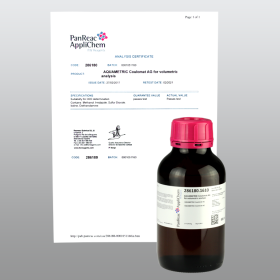
Coulometric determination

• Indicator electrode: Detects the moisture
• Generator electrode: Transmits a very low electric current causing the iodide oxidation into iodine.
The iodine required for the reaction with the water in the sample is generated in situ (in the titration beaker) using a reagent solution containing iodide.
When water is detected:
I- ➝ I2 + H2O ➝ I-
A measuring system of the current generated in the titration is used to determine coulometrically the amount of water.
There are two different types of coulometric cells: those with and those without a diaphragm.
Cells with diaphragm
The anode chamber is separated from the cathode chamber with a diaphragm. Oxidation of I– to I2 occurs at the anode and the reduction of protons to H2 occurs at the cathode. Two reagents are needed:
- AQUAMETRIC® Coulomat A or AG for the anode chamber
- AQUAMETRIC® Coulomat CG for the cathode chamber
Main advantage:
- Highest accuracy
Cells without diaphragm
The anodic and cathodic compartments are not separated and only one reagent, the anolyte, is needed. The reactions are performed in the same electrolyte:
- AQUAMETRIC® Coulomat AG
Main advantage
- More convenient